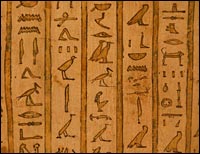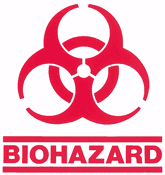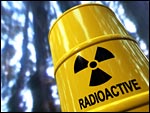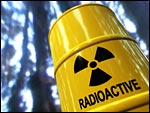Think of a mummy movie — any mummy movie.
Treasure hunters enter a pyramid. The explorers either ignore or can’t read the hieroglyphics warning of the curse that awaits those who open the 3,000-year-old sarcophagus before them. The mummy awakens and kills most of the cast.

Rough translation: Seriously dude,
do not open this door.
Photo: iStockphoto
If only those ancient Egyptians had done a better job warning future treasure-hunters not to mess with their sarcophagi.
Today, the U.S. government faces a similar task: figuring out how to warn descendants hundreds to thousands of years in the future about buried nuclear waste — material that can remain deadly for millennia. As cleanups proceed at shuttered sites and talk brews about building new plants, the question is more pressing than ever.
How do you tell someone centuries from now not to dig up radioactive waste from a burial site that may be long-forgotten, or from a place that’s attractive to the curious? A thousand years from now, will the United States still exist? Will an earthquake or volcano have wrecked the burial site? Will the people understand English? Who will show up at an ancient, possibly forgotten burial mound in the year 3000 A.D. — Mad Max, or the Jetsons, or someone we can’t even imagine?
While the Department of Energy has held preliminary discussions about some scattered nuclear waste and uranium tailing sites, there has been no coordination between the sites so far. “We’re very concerned about it,” says Ray Plieness, acting director for land and site management for DOE’s fledgling Office of Legacy Management, established in late 2003 to clean up the nation’s messes. “We’re in the infancy stages in discussing it.”
Dear Future People: Oops
Richland, Wash., home of the Hanford nuclear site, is often cited as the most radioactively and chemically contaminated spot in the Western Hemisphere. This is where the world’s first industrial-sized nuclear reactor was built, where the plutonium for the first atomic bombs originated. Today, Hanford has hundreds of contaminated buildings, including nine long-shutdown reactors and five closed chemical-processing plants, each slightly bigger than an average World War II battleship.
Hanford is one of a few dozen former nuclear production sites scattered across the nation, relics of the Cold War that include sprawling facilities at Idaho Falls, Idaho, and Savannah River, S.C. Across the country, the government is undertaking more than 100 cleanup projects at such sites. All the projects have a common thread: they’ll end up burying wastes with half-lives of up to thousands of years.

Inside the storage facility at Carlsbad,
N.M.
Photo: Sandia National Laboratories
The best-known burial sites are a half-mile deep artificial cavern near Carlsbad, N.M., and the controversial proposed site at Yucca Mountain, Nev. More waste will be or already is buried at Hanford, Savannah River, Idaho Falls, and elsewhere.
Much of the waste is supposed to be kept isolated for 10,000 years — more than twice the age of the beat-up and cryptic pyramids and Stonehenge. Right now, these DOE sites are usually protected with “keep out” signs, chain-link fences, and guards. However, there’s no guarantee that any of those measures will be feasible more than a few decades from now.
The problem of how to produce more permanent warnings is coming up quickly for Hanford, where a battleship-sized plutonium extraction factory — a place dubbed “U Plant” — is supposed to be buried under a huge on-site mound by 2012. That and similar sites may prove tempting places to dig centuries from now. “You’ve got to think of reverse psychology,” says Kevin Leary, DOE’s technical leader for the U Plant project. “What if you tweaked someone’s curiosity [to dig instead of avoid digging]?”
At Hanford, a rough rule of thumb for planners is to look ahead 1,000 years. That’s like a Viking trying to conceive of an astronaut, then trying to pass a note to him.
Experts inside and outside of DOE have pondered this communication conundrum. The agency has assembled panels of scientists, historians, artists, and others to tackle from all angles the question of how a 21st century sign should look to a 31st century person. From symbols to colors to materials to size, everything’s up for grabs — and nothing’s been decided. The leading plans for the major sites in New Mexico and Nevada involve enormous berms, monuments, time capsules, and more. Meanwhile, detractors say that will only draw unnecessary attention, and suggest that the best notification is no notification at all.
Amidst the uncertainty, Jim Wise, an associate professor of psychology and adjunct professor of environmental science at Washington State University, led a course last year on developing nuclear warning systems. Wise says the ultimate solution doesn’t have to be a shot in the dark: “There is enough evidence to make some responsible decisions.”
Color Me Radioactive
Pointing out that many of the potential warning designs suggested to date stress creativity and beauty rather than rigorously analyzing the psychology of what someone in 3000 A.D. might understand, Wise paints a picture of the challenges ahead.
Look at manuscripts from England that survived from 1000 A.D., Wise says. First of all, very few of those documents made the 1,000-year journey entirely intact. And the written English is indecipherable to most people today. Although we understand some aspects of what life was like then, most of that era is a mystery to us. Given our track record of understanding 1000 A.D.’s communications, Wise speculates that a nuclear-waste burial site would need at least seven different types of warnings in order for at least one to survive 1,000 years and be interpreted correctly.
Now take into consideration that language, science, and technology have evolved much faster in the past 200 years than in the previous 800. And future changes will likely accelerate over the next millennium. After all, videotapes were state of the art in the 1980s, and are antiquated today. Computers become obsolete in less than five years — so what are the chances of a warning sign lasting 1,000 years at a nuclear burial site? The bottom line is, no one knows what to expect.
In 2005, along with undergraduate student Stuart Davis, Wise met with DOE officials at Hanford to discuss the findings of his class. Many of the group’s ideas, says Plieness, have come up in discussions at other DOE sites as well.
As far as materials go, Wise and Leary think ceramics — perhaps buried at varying depths above the waste — might do the job. Others suggest concrete or stone. Wise fears that steel and most metals would likely corrode or be salvaged for some other purpose during the next several hundred years. One anti-theft device might be to use the burial mound itself as a warning, Wise says, noting that furrows and ridges could be incorporated in the design so the wind blowing across would make a sinister sound — or that long-lived, prickly vegetation could be planted on or around the sites.

Whatever the size of the warning, Wise suggests following nature’s lead by using bright colors, long an indicator from one creature to another to back off. These include a bee’s black and yellow stripes, a coral snake’s red and yellow stripes, a monarch butterfly’s wings — even the exaggerated contrast between the pupils and whites of human eyes, which allow others to read fear.
Wise contends that any warnings should be based on universal symbols of danger: things like sharp teeth, claws, lightning bolts, even today’s biohazard symbol. “As forms get sharper and get more edges, people dislike them, even in abstract images,” he says.
Circles and other symmetrical images, on the other hand, are comfortable at a gut level. And that immediately raises red flags. Today’s universal sign for prohibited items — a red circle with a diagonal slash — could easily be knocked askew over the next few hundred years, ending up looking more like a pictograph of a hamburger, Davis says. And the well-known skull-and-crossbones symbol, also symmetrical, won’t necessarily retain its meaning. “Someone might find a copy of Pirates of the Caribbean, and say there’s buried treasure there [where a skull-and-crossbones marker is found],” Davis adds.

Photo: iStockphoto
And what about today’s radiation warning sign? “It’s unfortunate that the radiation symbol looks the way it does, because it doesn’t look very threatening,” Wise says. “Someone might look at it and ask: ‘Why did someone bury all these propellers?'”
Go Tell It On the Mountain
Wise’s group suggested sending a warning to future generations through “memory stewardship” — essentially ingraining the dangers of radiation into folklore that’s passed from generation to generation. The need for awareness is underscored by DOE’s Plieness, who says it could also be achieved by teaching about the waste sites in local schools.
Plieness also says it will be necessary to plan for technology evolving into unforeseen forms, by setting up administrative rules that would require pertinent nuclear-waste information to be added to and stored in whatever state-of-the-art information system exists at that time. Sounds straightforward, but there are almost too many unknowns to analyze.
For his part, Wise hopes that a survey similar to one Davis conducted — which asked 75 southeastern Washington residents what symbols, shapes, and colors inspired the most fear, with lightning, triangles, and red and black the top vote-getters — will be conducted across other nations and cultures. This, he says, could help gauge what will truly speak to every culture’s gut, now and down the unknown road.


